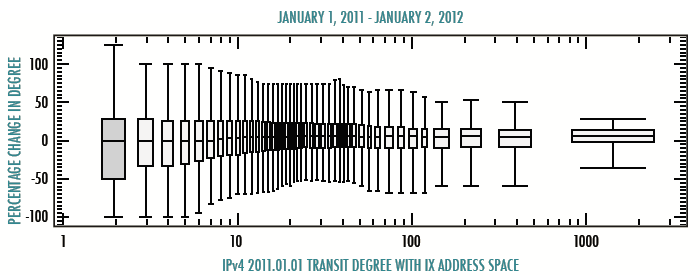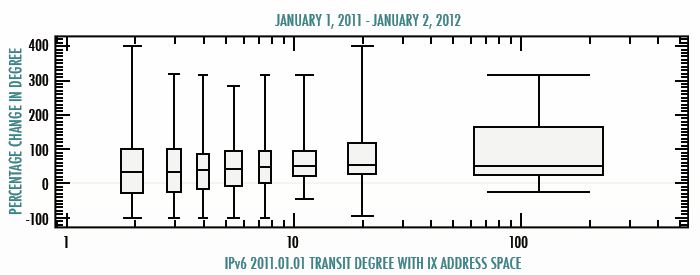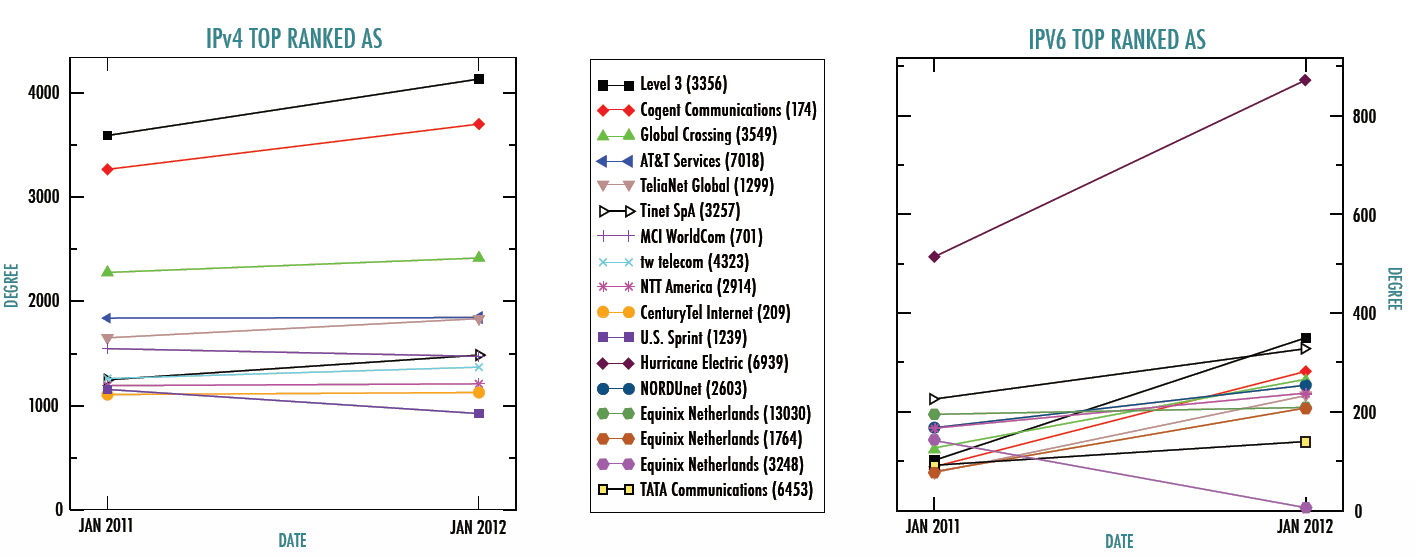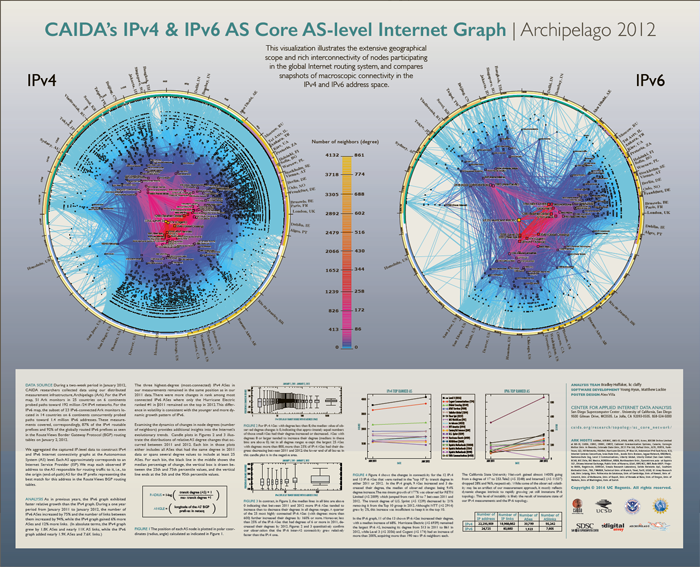IPv4 and IPv6 AS Core: Visualizing IPv4 and IPv6 Internet Topology at a Macroscopic Scale in 2012
Since 2000, CAIDA has generated AS Core graphs -- Internet Topology Maps also referred to as AS-level Internet Graphs -- in order to visualize the shifting topology of the Internet over time, as can be seen in the historical view.
Presented below is CAIDA's 2012 visualization of both IPv4 and IPv6 Internet topology at the Autonomous System (AS) level.
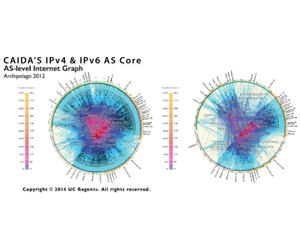
Figure 1. IPv4 and IPv6 AS Core Jan 2012.
Data Source
This visualization represents a macroscopic snapshot of IPv4 and IPv6 Internet topology samples captured in 2012. The plot illustrates both the extensive geographical scope as well as rich interconnectivity of nodes participating in the global Internet routing system.
For the IPv4 map, CAIDA collected data from 51 monitors in 25 countries on 6 continents. Coordinated by our active measurement infrastructure, Archipelago (Ark), the monitors probed paths toward 192 million /24 networks that cover 87% of the routable prefixes seen in the Route Views Border Gateway Protocol (BGP) routing tables in January 2014. For the IPv6 map, CAIDA collected data from 23 IPv6-connected Ark monitors located in 14 countries on 6 continents. This subset of monitors probed paths toward 1.4 million IPv6 addresses, which represent 92% of the globally routed IPv6 prefixes seen in Route Views BGP tables in January 2012.

Figure 2. Coordinates of AS in AS core visualization.
We aggregated the captured IP-level data to construct IPv4 and IPv6 Internet connectivity graphs at the Autonomous System (AS) level. Each AS approximately corresponds to an Internet Service Provider (ISP). We map each observed IP address to the AS responsible for routing traffic to it, i.e., to the origin (end-of-path) AS for the IP prefix representing the best match for this address in the Route Views BGP routing tables.
The position of each AS node is plotted in polar coordinates (radius, angle) calculated as indicated in Figure 2, on the right.
Methodology
For a detailed explanation of the methodology used in generating AS Core visualizations, see the main IPv4 & IPv6 AS Core page.
Changes in the graph since 2011
As in previous years, the IPv6 graph exhibited faster relative growth than the IPv4 graph. During a one year period from January 2011 to January 2012, the number of IPv6 ASes increased by 75% and the number of links between them increased by 94%, while the IPv4 graph gained 6% more ASes and 12% more links. (In absolute terms, the IPv4 graph grew by 1.8K ASes and nearly 11K AS links, while the IPv6 graph added nearly 1.9K ASes and 7.6K links.)
The three highest-degree (most-connected) IPv4 ASes in our measurements remained in the same position as in our 2011 data. There were more changes in rank among most connected IPv6 ASes where only the Hurricane Electric ranked #1 in 2011 remained on the top in 2012. This difference in volatility is consistent with the younger and more dynamic growth pattern of IPv6.
Examining the dynamics of changes in node degrees (number of neighbors) provides additional insights into the Internet's evolutionary trends. Candle plots in Figures 2 and 3 illustrate the distributions of relative AS degree changes that occurred between 2011 and 2012. Each bin in those plots either includes all ASes that had the same degree in 2011 data or spans several degree values to include at least 25 ASes. For each bin, the black line in the middle shows the median percentage of change, the vertical box is drawn between the 25th and 75th percentile values, and the vertical line ends at the 5th and the 95th percentile values.
|
Figure 3. IPv4 2012.01.01 transit degree inferred across IX address space
|
Figure 4. IPv6 2012.01.01 transit degree inferred across IX address space
|
Figure 3 shows that for IPv4 ASes with degree less than 8, the median value of observed degree changes is 0, indicating that approximately equal numbers of those small ASes had their degree increased or decreased. ASes with degrees 8 or larger tended to increase their degree (medians in these bins are above 0). Yet in all degree ranges except the largest 25 ASes with degrees more than 800, more than 25% of IPv4 ASes had their degrees decreasing between 2011 and 2012: the lower end of all boxes in this candle plot is in the negative area.
In contrast, in Figure 4, the median lines in all bins are above 0 indicating that between 2011 and 2012 more IPv6 ASes tended to increase than to decrease their degrees in all degree ranges. A quarter of the 25 most highly connected IPv6 ASes (with degrees more than 600) further increased their degrees by 160% or nore. Moreover, less than 25% of the IPv6 ASes that had degrees of 6 or more in 2011, decreased their degrees by 2012. Figures 2 and 3 quantitatively confirm our observation that the IPv6 inter-AS connectivity grew relatively faster than the IPv4 one.
|
Figure 5. IPv4 Top Ranked AS
|
Figure 5 shows the changes in connectivity for the 12 IPv4 and 13 IPv6 ASes that were ranked in the "top 10" by transit degree in either 2011 or 2012. In the IPv4 graph, 9 ASes increased and 3 decreased their degree, the median of observed changes being 9.4% degree increase. The maximum growth of 177% was observed for RETN Limited (AS 2009) which jumped from rank 30 to 7 between 2011 and 2012. The transit degree of U.S. Sprint (AS 1239) decreased by 21% removing it from the Top 10 group in 2012. Althought NTT (AS 2914) grew by 2%, this increase was insufficient to keep it in the top 10.
In the IPv6 graph, 11 of the 13 shown IPv6 ASes increased their degree, with a median increase of 68%. Hurricane Electric (AS 6939) remained the largest IPv6 AS, increasing its degree from 513 in 2011 to 861 in 2012, while Level 3 (AS 3356) and Cogent (AS 174) had an increase of more than 200%, acquiring more than 190 new IPv6 neighbors each. The California State University Network gained almost 1400% going from a degree of 17 to 253. Tele2 (AS 3248) and Internet2 (AS 11537) dropped 28% and 96%, respectively. While some of the observed volatility may be an artifact of our measurement approach, it mostly reflects dynamic changes intrinsic to rapidly growing yet still immature IPv6 topology. This level of instablity is likely the result of immature state of our IPv4 measurements and the IPv6 topology.
For more information about the topology mapping project, see: https://www.caida.org/projects/macroscopic/
For details on a more sophisticated methodology for ranking AS interconnectivity, based on inferring AS relationships from BGP data, see CAIDA's Introduction to Relationship-based AS Ranking at https://www.caida.org/catalog/datasets/as-relationships/.
Demonstration
If you would like to try out a demo of the CAIDA tools used to construct this graph, please see https://www.caida.org/projects/internetatlas/gallery/ascore/demo.
Poster
(PNG image) (PDF in 9:11 aspect ratio or 11:17 aspect ratio)
Acknowledgments
CAIDA
Topology Mapping Analysis Team: Brad Huffaker, kc claffy
Software Development: Young Hyun, Matthew Luckie
Poster
Design: Alex Villa


